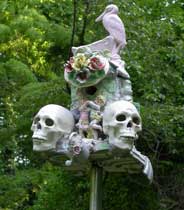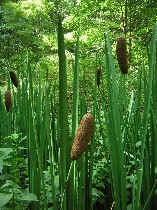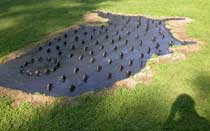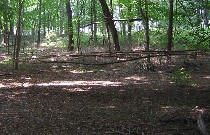 I drove to Abington Art Center on the hottest day of the summer to wander through the gardens looking at all the outdoor sculpture in “Passages” about which Roberta had some kind things to say a while back here. The indoor pieces were temporarily down for the month to make way for children’s art; if I had known, I would have postponed, alas. But I did enjoy the garden and the woods, even in the heat, and the old as well as the new “Passages” sculptures. I’m just writing about the latter, however.
I drove to Abington Art Center on the hottest day of the summer to wander through the gardens looking at all the outdoor sculpture in “Passages” about which Roberta had some kind things to say a while back here. The indoor pieces were temporarily down for the month to make way for children’s art; if I had known, I would have postponed, alas. But I did enjoy the garden and the woods, even in the heat, and the old as well as the new “Passages” sculptures. I’m just writing about the latter, however.
Abington’s curator Amy Lipton invited the five participating artists to create site-specific works that reference passages or transitions in their work and in the evolving landscape.
I was crazy about Joan Bankemper’s “A Dovetail Garden,” a series of birdhouses made from bric-a-brac and surrounded by little plantings to attract birds. The contrast between the plantings, just plain beautiful, and the loaded kitsch of the bric-a-brac with its cultural baggage and saccharine overtones highlight our sometimes deviant passion for decoration.
To apply Louis XIV taste for crockery shepherds and shepherdesses (at least that’s what they looked like to me), or Halloween skulls (lots of holes for birds to enter), or a 1930s-style hollow white glam nude with the bellybutton as a bird hole were funny. Yet they all seemed right in place in the garden, their material serving as a reference to more familiar ceramic garden decorations like birdbaths and pink flamingos.
According to the gallery notes, each of Bankemper’s birdhouses stand for a different life passage, “including adolescence, womanhood, marriage, motherhood and spirituality.” I sure did miss that, but loved what I didn’t miss and what I plain old made up.
 Lisa Murch’s “Typha Latifolia (Cattails)” made of painted vertical window blind slats also bring indoor decoration to outdoor nature. The cattails look real from far; closeup, the brown shellacked flowers look like poop on a stick; the leaves, however, still hold up and blend right in with the real stuff. It’s silk flowers for better homes and gardens. I previously posted on Murch’s work here.
Lisa Murch’s “Typha Latifolia (Cattails)” made of painted vertical window blind slats also bring indoor decoration to outdoor nature. The cattails look real from far; closeup, the brown shellacked flowers look like poop on a stick; the leaves, however, still hold up and blend right in with the real stuff. It’s silk flowers for better homes and gardens. I previously posted on Murch’s work here.
 And Warren Angle’s “La Brea” is his personal tar pit, shaped like the U.S.A., with a circle of tarry duck heads for the stars and rows of tarry duck heads for the stripes. Like the oil and like the ducks, the pollution is migrating across the nation, if not across the world. But let’s face it. Both ducks and pollution know no national boundaries. Unfortunately, weather and the passage of time and gardeners have put a dusty film of soil and dried grass clippings over “La Brea,” polluting the piece. Maybe that’s the point.
And Warren Angle’s “La Brea” is his personal tar pit, shaped like the U.S.A., with a circle of tarry duck heads for the stars and rows of tarry duck heads for the stripes. Like the oil and like the ducks, the pollution is migrating across the nation, if not across the world. But let’s face it. Both ducks and pollution know no national boundaries. Unfortunately, weather and the passage of time and gardeners have put a dusty film of soil and dried grass clippings over “La Brea,” polluting the piece. Maybe that’s the point.
 Also in “Passages” are a piece by Michele Brody–that looked like a lace version of a New York apartment building awning with grass growing in pockets along the sides, a little precious–and by Roy Staab–a piece with floating circles of non-native saplings, barely visible in the woods . There was a certain wonder to the visually non-intrusive rings of an intrusive species hanging there amid the vertical trunks. I’m channeling some Peter Kinney work I saw a number of years ago with its delicate balance and shamanistic vibe (image, detail of Staab’s “Katsura Passage,” with rings of Norwegian maple saplings hung from a katsura tree–also not native).
Also in “Passages” are a piece by Michele Brody–that looked like a lace version of a New York apartment building awning with grass growing in pockets along the sides, a little precious–and by Roy Staab–a piece with floating circles of non-native saplings, barely visible in the woods . There was a certain wonder to the visually non-intrusive rings of an intrusive species hanging there amid the vertical trunks. I’m channeling some Peter Kinney work I saw a number of years ago with its delicate balance and shamanistic vibe (image, detail of Staab’s “Katsura Passage,” with rings of Norwegian maple saplings hung from a katsura tree–also not native).









